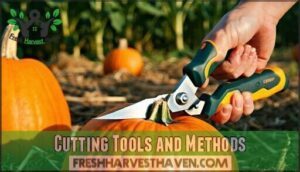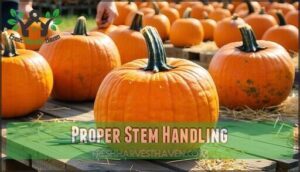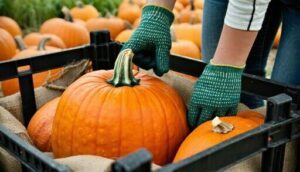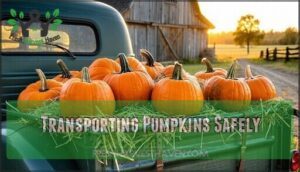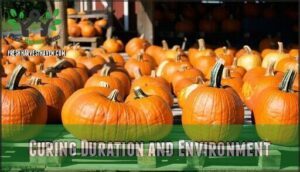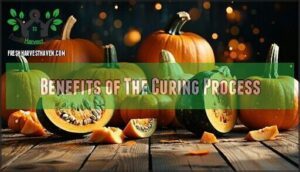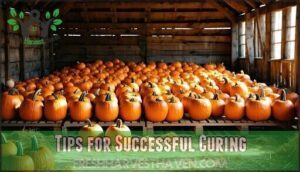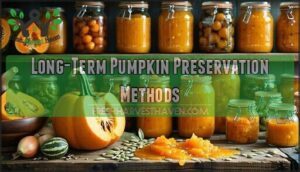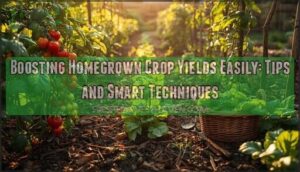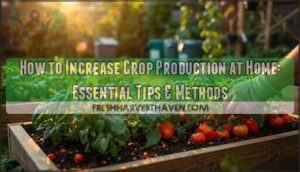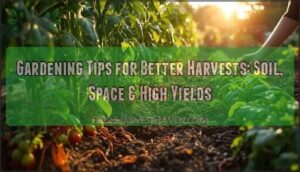This site is supported by our readers. We may earn a commission, at no cost to you, if you purchase through links.
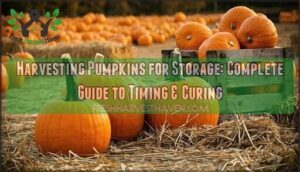
This curing process triggers natural sugar development and rind hardening that extends shelf life substantially.
Store cured pumpkins at 50-60°F with moderate humidity and gentle air circulation, handling them carefully by supporting from the bottom rather than lifting by stems. Your properly harvested and cured pumpkins can maintain quality for 3-6 months, though specific storage techniques and preservation methods can extend their usability even further.
Table Of Contents
- Key Takeaways
- When to Harvest Pumpkins for Storage
- Essential Pumpkin Harvesting Techniques
- Curing Pumpkins to Maximize Shelf Life
- Best Storage Conditions for Pumpkins
- Long-Term Pumpkin Preservation Methods
- Frequently Asked Questions (FAQs)
- How do you store pumpkins after harvesting?
- When should you pick pumpkins off the vine?
- How do you keep pumpkins from rotting after harvest?
- How do you clean pumpkins for storage?
- What happens if you leave pumpkins on the vine too long?
- How long will pumpkins last after being picked?
- How to store Pumpkins after they are harvested?
- How do you store a cured pumpkin?
- How long do Pumpkins last after harvest?
- Do pumpkins need to be stored long-term?
- Conclusion
Key Takeaways
- Harvest when pumpkins show deep orange color and hard rinds – You’ll know they’re ready when your fingernail can’t dent the skin and the stem appears dry and woody.
- Cut stems 2-4 inches long using sharp tools – You’ll prevent rot by maintaining proper stem length and making clean cuts that don’t create disease entry points.
- Cure for 10 days at 80-85°F before storage – You’ll toughen the skin and develop natural sugars by exposing pumpkins to warm, humid conditions with good airflow.
- Store at 50-60°F with moderate humidity and air circulation – You’ll extend shelf life to 3-6 months by maintaining cool temperatures and preventing moisture buildup that causes rot.
When to Harvest Pumpkins for Storage
You’ll know your pumpkins are ready for storage when they display a deep, uniform orange color and produce a hollow sound when tapped.
The rind should feel hard enough that you can’t easily dent it with your fingernail, and the stem should appear dry and woody rather than green and fresh.
Identifying Mature Color
Looking at ripe pumpkins, you’ll spot deep, uniform color development across the entire rind. Check for consistent orange hues without green patches, which signal incomplete maturity.
Harvesting pumpkins requires recognizing varietal differences—some winter squash varieties display cream, blue, or tan coloring. Spotting imperfections like soft spots helps determine readiness.
Remember, post-harvest changes won’t improve color uniformity once picked.
Checking Rind Hardness
Beyond color, you’ll need to test your pumpkin’s rind hardness using simple pressure techniques. Press your fingernail firmly against the skin—mature pumpkins resist indentation, while unripe ones dent easily.
A properly hardened rind feels like thick plastic and protects pumpkin seeds during long-term storage.
Different varieties show varietal rind differences, but ideal hardness level remains consistent across types for successful harvesting pumpkins and how to store pumpkins effectively.
Monitoring Size and Stem
A mature pumpkin’s size should match your variety’s ideal size range, usually 8-20 pounds for storage types. The stem should appear dry and corky, not green or soft, which prevents stem rot during longterm storage. Check stem attachment strength by gently tugging; loose stems indicate overripeness.
A key indicator is that the vine begins dying back naturally. Size uniformity across your pumpkin harvest indicates proper growth stage correlation, helping you determine the best time for how to harvest pumpkins.
Avoiding Frost Damage
Frost timing matters most when harvesting pumpkins for longterm storage. You’ll need immediate action once temperatures drop below 32°F, as frost damage ruins pumpkin skin and reduces storage life. Check weather forecasts regularly and harvest before the first hard frost hits.
Variety selection affects frost tolerance, but no pumpkin survives prolonged freezing. Climate impact varies by region, so know your area’s typical frost dates.
Protective measures like row covers buy extra time, but don’t rely on them indefinitely when storing pumpkins properly.
Essential Pumpkin Harvesting Techniques
Once you’ve identified mature pumpkins ready for harvest, proper harvesting techniques guarantee they’ll store well throughout the winter months.
Using the right tools and handling methods prevents damage that could lead to premature spoilage during storage.
Cutting Tools and Methods
You’ll need sharp pruning shears or a serrated knife for harvesting pumpkins effectively. Choose tools with ergonomic grips and quality blade material to reduce hand fatigue during extended harvesting sessions.
Cut at proper angles, leaving 2-4 inches of stem attached. Consider specialized pumpkin harvesting shears for ideal cutting. Keep the stem intact for better storage longevity.
Regular tool maintenance ensures clean cuts that prevent disease entry points.
Proper Stem Handling
When harvesting pumpkins, you’ll want to leave 2-3 inches of stem attached—this stem length matters for preventing rot during room temperature storage. Cut at a suitable stem angle using sharp, clean tools to maintain stem attachment strength.
Proper curing helps extend storage life. Proper curing
If you’re dealing with broken stems, don’t panic; these pumpkins can still be stored but should be used first since handling broken stems increases vulnerability to decay.
Skin Protection and Damage Prevention
Carefully protect your pumpkin’s skin during harvesting to prevent damage that leads to premature spoilage. Handle each pumpkin gently, as bruising creates entry points for rot-causing bacteria.
- Handling Abrasions: Wear gloves and avoid dragging pumpkins across rough surfaces to prevent skin scratches
- Bruise Minimization: Support the full weight when lifting to avoid dropping or bumping against hard objects
- Sun Damage: Harvest during cooler morning hours to prevent overheating and skin weakening
- Pest Control: Remove any attached insects or debris that could damage the rind during storage
Transporting Pumpkins Safely
Moving pumpkins from field to storage requires strategic planning and gentle handling techniques. Choose a vehicle with low sides or a wagon to minimize lifting height when transporting your harvest. Plan your route to avoid bumps that could bruise winter squash during transport.
Use proper lifting techniques by keeping the stem intact and adding pumpkin padding between layers. Secure strapping prevents rolling damage while storing your harvest safely.
Curing Pumpkins to Maximize Shelf Life
After you’ve successfully harvested your pumpkins at the right time, proper curing becomes essential for extending their storage life from weeks to months.
You’ll need to expose your freshly picked pumpkins to warm, dry conditions for about 10 days to toughen their skin and heal any minor cuts before long-term storage.
Temperature and Humidity Control
Ideal temperature control creates the foundation for successful pumpkin curing. Room temperature between 80-85°F accelerates skin hardening while preventing decay. Managing airflow and humidity prevents condensation that damages your harvest during storage.
Here’s your temperature and humidity roadmap:
- Maintain 80-85°F temperatures – This sweet spot hardens pumpkin skin without dehydrating the flesh too quickly
- Keep humidity at 85-90% – High moisture levels prevent premature drying while allowing proper curing chemistry
- Guarantee gentle air circulation – Steady airflow prevents condensation buildup that leads to rot and extends storage longevity
Curing Duration and Environment
Everyone knows the secret to long-lasting pumpkins lies in proper curing timeframes and environment. You’ll need 10 days of curing in sunlight exposure with ideal airflow. Ventilation importance can’t be overstated—humidity effects will ruin your harvest without proper air circulation around each pumpkin.
| Environment Factor | Optimal Range | Impact on Shelf Life |
|---|---|---|
| Temperature | 80-85°F | Hardens skin, extends storage |
| Humidity | 50-70% | Prevents mold, maintains firmness |
| Airflow | Continuous gentle | Reduces moisture buildup |
| Sunlight | Direct 6-8 hours | Strengthens rind naturally |
| Duration | 10-14 days | Maximizes storage potential |
Benefits of The Curing Process
Curing transforms your pumpkins from good to great. This process triggers sugar development, making flesh sweeter and more flavorful. Rind hardening creates a natural protective barrier that prevents rot and extends shelf life substantially.
You’ll store pumpkins longer when curing enhances their natural defenses against moisture and decay. To guarantee proper curing, maintain ideal temperature conditions.
Tips for Successful Curing
Success hinges on creating the right curing environment with proper air circulation and humidity levels. You’ll want temperatures between 80-85°F with 80-85% humidity for ideal sweetness enhancement.
Space your pumpkins in a single layer to prevent rot and turn them midway through the 10-day process. Proper curing also involves ensuring good air circulation around each pumpkin. This careful attention extends shelf life substantially.
Best Storage Conditions for Pumpkins
After you’ve cured your pumpkins properly, creating the right storage environment becomes essential for maximizing their shelf life.
You’ll need to maintain specific temperature and humidity conditions while ensuring proper air circulation to keep your pumpkins fresh for months.
Ideal Storage Temperature
Store pumpkins between 50°F and 60°F for maximum shelf life, as temperature monitoring prevents premature spoilage. Varietal differences affect storage longevity, with thick-skinned varieties tolerating temperature fluctuations better.
Refrigerator temperatures work well for cut pieces, while whole pumpkins prefer slightly warmer conditions. Avoid freezing whole pumpkins, as cellular damage occurs below 32°F, compromising quality.
Humidity and Air Circulation
Beyond temperature control, maintaining proper humidity levels and airflow prevents the nightmare scenarios that plague pumpkin storage. Aim for 50-70% humidity with gentle air circulation to ward off mold and rot that can destroy your harvest within weeks. With proper techniques, pumpkins can be kept fresh for 2-6 months, and some varieties last longer.
Here are three circulation methods to store pumpkins successfully:
- Root cellar ventilation – Install small fans or vents to create gentle airflow without direct drafts.
- Slatted shelving systems – Use wooden slats or wire racks that allow air to flow around each pumpkin.
- Strategic spacing – Place pumpkins 2-3 inches apart so air can circulate between them naturally.
Humidity effects become apparent quickly when levels exceed 80%—you’ll notice soft spots and fuzzy mold growth. Conversely, airflow benefits include extended shelf life and reduced rotting risks. Poor circulation creates stagnant pockets where moisture accumulates, turning your storage area into a breeding ground for decay. Monitor humidity with a simple gauge and adjust ventilation accordingly for ideal mold prevention.
Suitable Storage Locations and Materials
Choose your storage spot wisely – basements, garages, or root cellars work best for maintaining Location Temperature Control around 50-60°F.
Material Breathability matters, so avoid plastic bags that trap moisture and reduce Shelf Life. Instead, use wooden crates or cardboard boxes that allow air circulation while protecting from Sunlight Exposure, keeping your harvested pumpkins fresh longer. Consider using specialized pumpkin containers to prolong storage duration.
Handling and Inspection Tips
Handle your stored pumpkins like fragile treasures to maintain their quality throughout storage. Carry pumpkins from the bottom, never by the stem, and inspect weekly for damage prevention. Gently clean the rind and keep the stem attached while checking for rot detection during harvesting. Proper storage helps prevent spoilage, so maintain ideal temperature conditions for prolonged storage life.
- Your heart will sink when you discover a single rotted pumpkin has spoiled your entire harvest
- Feel the satisfaction of spotting early pest inspection signs before they spread to healthy pumpkins
- Experience the relief of safe lifting techniques that prevent costly bruising and surface damage
Long-Term Pumpkin Preservation Methods
When you’ve properly cured your pumpkins, you’ll want to explore long-term preservation methods that extend their usability well beyond traditional storage limits.
These techniques transform your harvest into convenient forms that maintain nutritional value while preventing spoilage for months or even years.
Refrigerator Storage
While room-temperature storage works well short-term, your refrigerator offers better shelf life extension for cut pumpkins. Keep pieces in airtight containers to prevent moisture loss and protect from ethylene gas effects from nearby fruits.
Refrigerator humidity levels around 95% help maintain texture, though temperature consistency matters more than space optimization for harvesting success.
Freezing Pumpkins
Freezing pumpkins offers excellent long-term storage, though texture changes occur during the process. You’ll want to cook pumpkins before freezing; methods like puréeing or cubing work best.
While nutritional impact remains minimal, frozen pumpkin works perfectly for soups, pies, and baked goods. Proper thawing techniques guarantee the best culinary uses when harvesting vegetables for winter meals.
Dehydrating Pumpkin
Dehydrating pumpkin transforms fresh flesh into concentrated nutrition powerhouses. You’ll retain most vitamins while creating adaptable pumpkin powder for baking, soups, and smoothies.
Slice your pumpkin plant harvest into thin pieces, then use your dehydrator or oven at 135°F. This dehydration method beats freezing pumpkins for long-term storage – properly stored dehydrated pieces last years, offering endless culinary uses.
Freeze-Drying for Extended Shelf Life
While dehydrating removes moisture through heat, freeze-drying preserves pumpkin’s cellular structure for enhanced nutritional retention and extended shelf life. This method creates lightweight pumpkin powder perfect for long-term storage. You can even purchase pre-made options online.
Freeze-drying offers several key advantages:
- Freeze-drying benefits include a 25-30 year shelf life versus dehydrating’s 1-2 years
- Nutritional retention stays at 97% compared to 60% with traditional dehydrating methods
- Texture changes remain minimal—rehydrated pumpkin tastes nearly fresh
- Rehydration methods are simple: add warm water and wait 5-10 minutes
- Cost analysis shows a higher upfront investment but better long-term value per serving
Frequently Asked Questions (FAQs)
How do you store pumpkins after harvesting?
Like a treasure needing proper care, you’ll cure pumpkins for ten days in sunshine or a warm, dry room before storing them at 50-60°F with moderate humidity for ideal longevity.
When should you pick pumpkins off the vine?
Pick pumpkins when they’re fully orange, the stem turns brown and woody, and your fingernail can’t dent the skin.
They’re usually ready 90-120 days after planting when vines start dying back naturally.
How do you keep pumpkins from rotting after harvest?
Proper curing prevents rot by toughening pumpkin skin naturally. Cure harvested pumpkins in sunshine for 10 days or in a warm, dry room before storing at 50-60°F with good airflow.
How do you clean pumpkins for storage?
Gently wipe pumpkins with a damp cloth to remove dirt and debris. **Don’t use soap or harsh chemicals.
Let them air-dry completely before storing to prevent moisture buildup that causes rot.
What happens if you leave pumpkins on the vine too long?
If you leave pumpkins on the vine too long, they’ll become overripe, developing soft spots and losing their vibrant color.
The shells may crack, making them susceptible to rot and substantially reducing their storage life.
How long will pumpkins last after being picked?
You’ve picked your orange treasures, but now they’re ticking time bombs of decay! Properly stored whole pumpkins last 2-3 months in cool, dry conditions.
You’ll need temperatures around 50-60°F with good ventilation to prolong their storage life.
How to store Pumpkins after they are harvested?
After harvest, cure pumpkins in sunlight or a warm, dry room for ten days. Then stash them in a cool, airy spot—think 50–60°F, with some humidity. Avoid stacking, and check for soft spots regularly.
How do you store a cured pumpkin?
Store your cured pumpkin in a cool, dry place with temperatures between 50-55°F and good air circulation. You’ll want to keep it off the ground on wooden shelves or cardboard, checking regularly for soft spots.
How long do Pumpkins last after harvest?
Properly cured pumpkins can last 2-6 months when you store them correctly. Keep them in cool, dry conditions around 50-60°F with good air circulation to prolong their shelf life.
Do pumpkins need to be stored long-term?
Like they say, "time heals all wounds," but pumpkins don’t need long-term storage. You’ll usually use them within 2-3 months after proper curing, making short-term storage sufficient for most purposes.
Conclusion
**Mastering harvesting pumpkins for storage transforms your autumn harvest from weeks to months of enjoyment.
** Your careful timing, proper cutting techniques, and dedicated 10-day curing process create the foundation for successful long-term storage.
When you combine ideal 50-60°F storage temperatures with gentle handling and regular inspections, you’ll preserve your pumpkins’ quality for up to six months. These proven methods guarantee your harvest remains fresh, whether you’re planning holiday decorations or delicious winter meals from your garden’s bounty.
- https://www.epicgardening.com/harvesting-pumpkins/
- https://www.youtube.com/watch?v=6RMMCQWEwlg
- https://vegcropshotline.org/article/maximizing-pumpkin-quality-from-harvest-to-storage/
- http://gardenerscott.com/gardenerscott-blog/harvesting-pumpkins
- https://vtechworks.lib.vt.edu/bitstreams/9ed0a0bc-96d2-4a00-8db2-30c3dc010884/download

